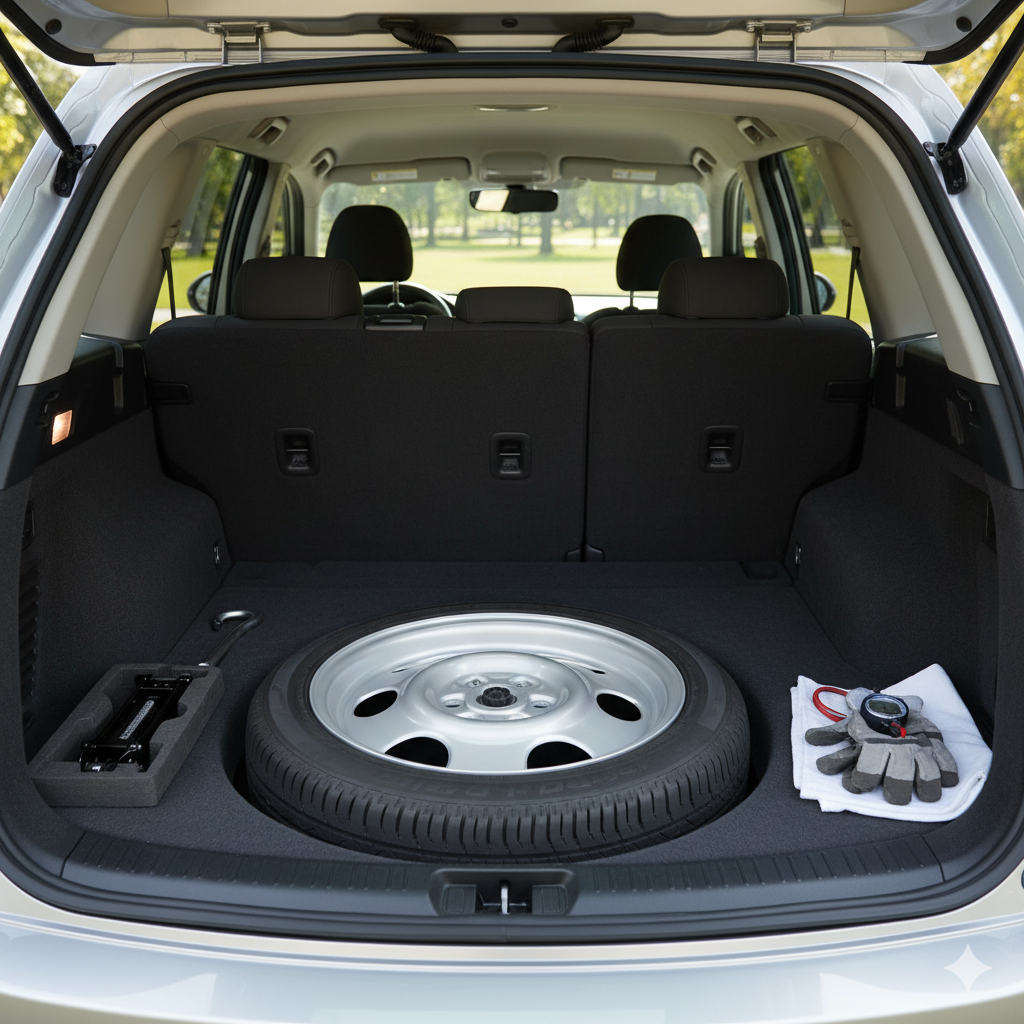Learning how to change a tire isn’t just about fixing a car; it’s about reclaiming control and turning a stressful moment into one of empowerment. Picture yourself driving along a serene backroad, the golden hues of dusk painting the sky, when a sudden thump-thump jolts you. Your heart races—you’ve got a flat tire. Stranded, with no service station in sight, the situation feels overwhelming. But what if you could handle it with calm confidence?
I’ve been there, wrestling with a flat in the pouring rain, and mastering this skill changed how I face unexpected challenges. Let’s walk through this together so you’re ready for anything the road throws your way.
Why Knowing How to Change a Tire Matters
Every driver faces the risk of a flat tire, whether from a stray nail or a sneaky pothole. Mastering how to change a tire means you’re prepared to tackle this common issue without relying on roadside assistance. It’s a practical skill that saves time, money, and stress, giving you independence on the road.
This knowledge isn’t just for emergencies—it’s a confidence booster. Whether you’re a new driver or a seasoned pro, understanding tire repair basics ensures you’re never stuck feeling helpless.
The Importance of Being Prepared for a Flat Tire
A flat tire can strike anywhere, from busy highways to quiet rural roads. Without the ability to change a tire, you might face long waits or costly tow fees. Being prepared means having the right tools and know-how to get back on the road quickly.
I once helped a neighbor who was late for a job interview because of a flat. With a quick tire swap, she made it on time. That moment showed me how this skill can truly save the day.
Tools You Need to Change a Tire

To change a tire successfully, gather these essentials, usually found in your car’s trunk: a spare tire, jack, lug wrench, and wheel chocks. Extras like a flashlight, gloves, and a tire pressure gauge make the process smoother and safer.
Keep these tools in good condition and check your spare tire’s air pressure monthly. A well-stocked roadside emergency kit is like having a trusted friend ready when you need it most.
Safety First: Precautions Before Changing a Tire
Safety is critical when learning how to change a tire. Always pull over to a flat, stable surface away from traffic. Turn on your hazard lights and place reflective triangles or flares if available to alert other drivers.
Engage the parking brake and avoid working on inclines. These steps protect you and ensure the tire-changing process goes off without a hitch.
Step 1: Find a Safe Location for Your Tire Change
Start by moving your car to a level, safe spot, like a parking lot or wide shoulder. If you’re on a highway, aim for an exit ramp to avoid traffic hazards. A secure location sets the foundation for a smooth tire repair.
Take a moment to breathe and assess your surroundings. Staying calm helps you focus on the task ahead without rushing into mistakes.
Step 2: Loosen the Lug Nuts on the Flat Tire
With the car on the ground, use your lug wrench to turn the lug nuts counterclockwise. Don’t remove them yet—just loosen them enough to break their initial resistance. This step in how to change a tire uses the car’s weight to make turning easier.
If the nuts are rusted, a spritz of penetrating oil or a gentle tap can help. Patience here prevents damaged threads later.
Step 3: Lift the Car Safely with a Jack
Locate the proper jack point near the flat tire—check your owner’s manual for specifics. Position the jack securely and raise the car until the tire is just off the ground. Never crawl under the vehicle during a tire change.
Ensure the jack is stable on firm ground. A steady lift keeps you safe and makes the next steps easier.
Step 4: Remove the Damaged Tire
Now, fully unscrew the lug nuts and place them in a safe spot, like a pocket or container, to avoid losing them. Grip the tire by the treads and pull it straight off, setting it flat to prevent rolling.
This step clears the way for your spare, bringing you halfway through how to change a tire with confidence.
Step 5: Install the Spare Tire
Align the spare tire’s holes with the wheel bolts and push it onto the hub. Hand-tighten the lug nuts as much as you can to secure the tire in place during your tire repair.

Double-check that the tire sits flush against the hub. A proper fit ensures safety when you hit the road again.
Step 6: Tighten the Lug Nuts Properly
Lower the car slightly so the spare tire touches the ground, then use the lug wrench to tighten the nuts in a star pattern. This ensures even pressure and a secure tire change.
Don’t overtighten—snug is enough for now. You’ll do a final check after lowering the car completely.
Step 7: Lower the Car and Final Inspections
Carefully lower the jack until the car is fully on the ground, then remove it. Give the lug nuts one final tighten in the star pattern. Use a tire pressure gauge to check the spare’s inflation.
Stow the flat tire and tools securely. Drive slowly to test the spare, and head to a mechanic soon for a permanent fix.
Common Mistakes to Avoid When Changing a Tire
One frequent error is forgetting the parking brake, which can cause the car to roll. Another is jacking up the car on uneven ground, risking collapse. Avoid rushing—taking your time ensures a safe tire change.
Skipping the spare tire pressure check is another pitfall. A flat spare won’t help, so always verify it’s ready.
Do’s and Don’ts for a Smooth Tire Change
Do: Practice changing a tire at home to build confidence. Don’t: Attempt a tire repair in heavy rain or traffic unless necessary.
Do: Keep a roadside emergency kit with gloves and a flashlight. Don’t: Ignore stuck lug nuts—use proper tools or seek help to avoid damage.
When to Call a Professional for Tire Issues
If your jack is unstable or the spare tire is damaged, it’s time to call a professional. Severe tire damage, like a shredded sidewall, also requires expert attention beyond a simple tire change.
There’s no shame in seeking help when safety is at stake. Knowing your limits is part of being a savvy driver.
Real-Life Story: My First Tire Change Triumph
I’ll never forget my first solo tire change on a chilly evening. Stranded on a quiet road, I felt the weight of panic. But step by step—loosening nuts, jacking up, swapping tires—I got it done in under 30 minutes. Driving away, I felt like I’d conquered the world.
That moment taught me that preparation and knowledge turn fear into victory. Your first step in how to change a tire can be just as empowering.
Maintaining Tires to Prevent Flats

Preventive care reduces the need to change a tire. Check tire pressure monthly, rotate tires every 6,000 miles, and inspect for wear or damage. Avoid potholes and curbs to keep tires in top shape.
Simple habits like these extend tire life, saving you from roadside surprises and keeping your journeys smooth.
Frequently Asked Questions
What if my car doesn’t have a spare tire? Some vehicles come with run-flat tires or an inflator kit instead. Check your trunk for options, or drive cautiously to a repair shop if possible.
How long should a tire change take? For beginners, expect 30-45 minutes. With practice, you can change a tire in 15-20 minutes, prioritizing safety over speed.
Can I change a tire on a sloped road? It’s risky—find flat ground if you can. If not, use wheel chocks and extra caution to prevent the car from rolling.
What extra tools make tire changing easier? A torque wrench for precise tightening and a tire repair kit for small punctures can enhance your roadside emergency preparedness.
How far can I drive on a spare tire? Spare tires are temporary—stick to 50-70 miles at low speeds (under 50 mph). Replace it with a full tire as soon as possible.
How often should I check my spare tire’s condition? Inspect it monthly alongside your regular tires. Ensure it’s properly inflated to the recommended PSI for emergency readiness.
What if my lug nuts won’t budge? Try a breaker bar for extra leverage or apply a penetrating lubricant. If they’re still stuck, a mechanic can assist to avoid damage.
Conclusion:
Learning how to change a tire is more than a practical skill—it’s a spark of self-reliance that lights up even the darkest roadside moments. With these steps, you’re equipped to handle flats with poise, turning potential chaos into a story of strength.
Keep practicing, stay prepared, and drive with the assurance that you’ve got this. Here’s to safe travels and the pride of mastering your own journey.





